Australian Education System: Framework, Impact, and Analysis Report
VerifiedAdded on 2023/03/30
|6
|988
|161
Report
AI Summary
This report provides a comprehensive overview of the Australian education system, detailing its structure across primary, secondary, and tertiary levels. It outlines the compulsory nature of education, the language of instruction, and the academic year. The report examines the framework of primary education, managed by the Australian government, and the two stages of secondary education, including the subjects offered and the secondary certificate. It also discusses the Australian Tertiary Admission Rank (ATAR) system for high education and the performance-based frameworks of universities. Furthermore, the report analyzes the impact of Australian education on society, particularly in terms of job prospects, technological advancements, health sector contributions, and economic benefits through international student programs. References to key academic sources support the analysis.
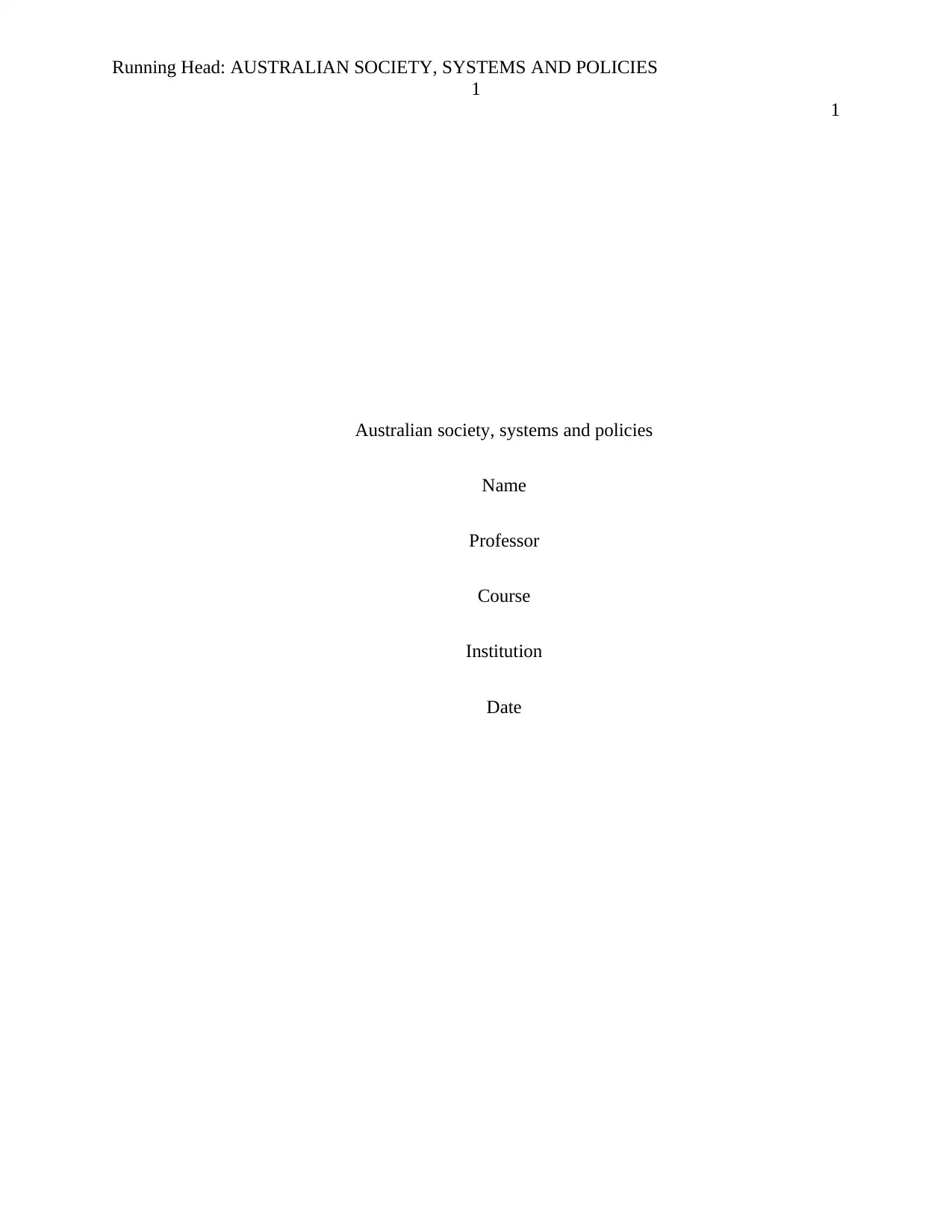
Running Head: AUSTRALIAN SOCIETY, SYSTEMS AND POLICIES
1
1
Australian society, systems and policies
Name
Professor
Course
Institution
Date
1
1
Australian society, systems and policies
Name
Professor
Course
Institution
Date
Paraphrase This Document
Need a fresh take? Get an instant paraphrase of this document with our AI Paraphraser
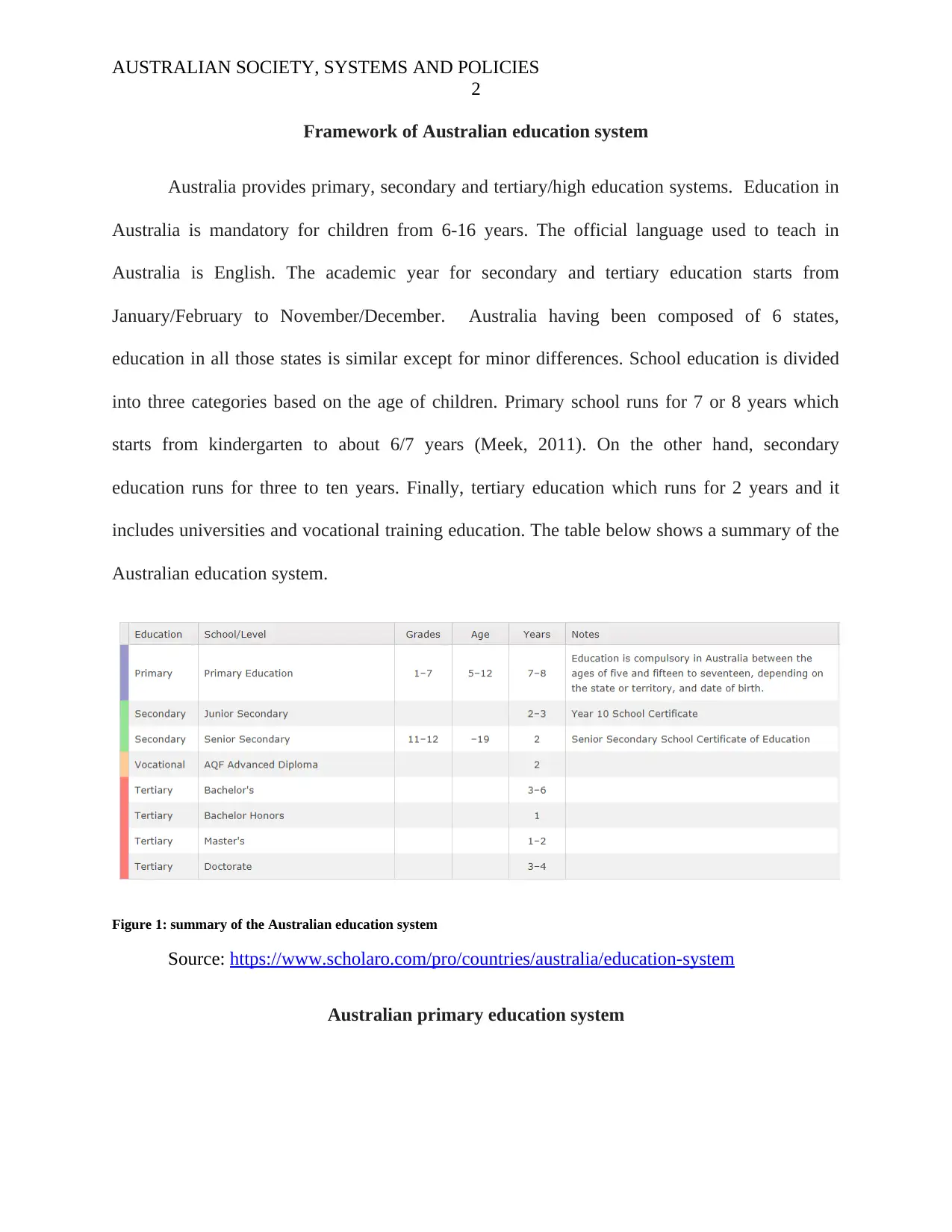
AUSTRALIAN SOCIETY, SYSTEMS AND POLICIES
2
Framework of Australian education system
Australia provides primary, secondary and tertiary/high education systems. Education in
Australia is mandatory for children from 6-16 years. The official language used to teach in
Australia is English. The academic year for secondary and tertiary education starts from
January/February to November/December. Australia having been composed of 6 states,
education in all those states is similar except for minor differences. School education is divided
into three categories based on the age of children. Primary school runs for 7 or 8 years which
starts from kindergarten to about 6/7 years (Meek, 2011). On the other hand, secondary
education runs for three to ten years. Finally, tertiary education which runs for 2 years and it
includes universities and vocational training education. The table below shows a summary of the
Australian education system.
Figure 1: summary of the Australian education system
Source: https://www.scholaro.com/pro/countries/australia/education-system
Australian primary education system
2
Framework of Australian education system
Australia provides primary, secondary and tertiary/high education systems. Education in
Australia is mandatory for children from 6-16 years. The official language used to teach in
Australia is English. The academic year for secondary and tertiary education starts from
January/February to November/December. Australia having been composed of 6 states,
education in all those states is similar except for minor differences. School education is divided
into three categories based on the age of children. Primary school runs for 7 or 8 years which
starts from kindergarten to about 6/7 years (Meek, 2011). On the other hand, secondary
education runs for three to ten years. Finally, tertiary education which runs for 2 years and it
includes universities and vocational training education. The table below shows a summary of the
Australian education system.
Figure 1: summary of the Australian education system
Source: https://www.scholaro.com/pro/countries/australia/education-system
Australian primary education system
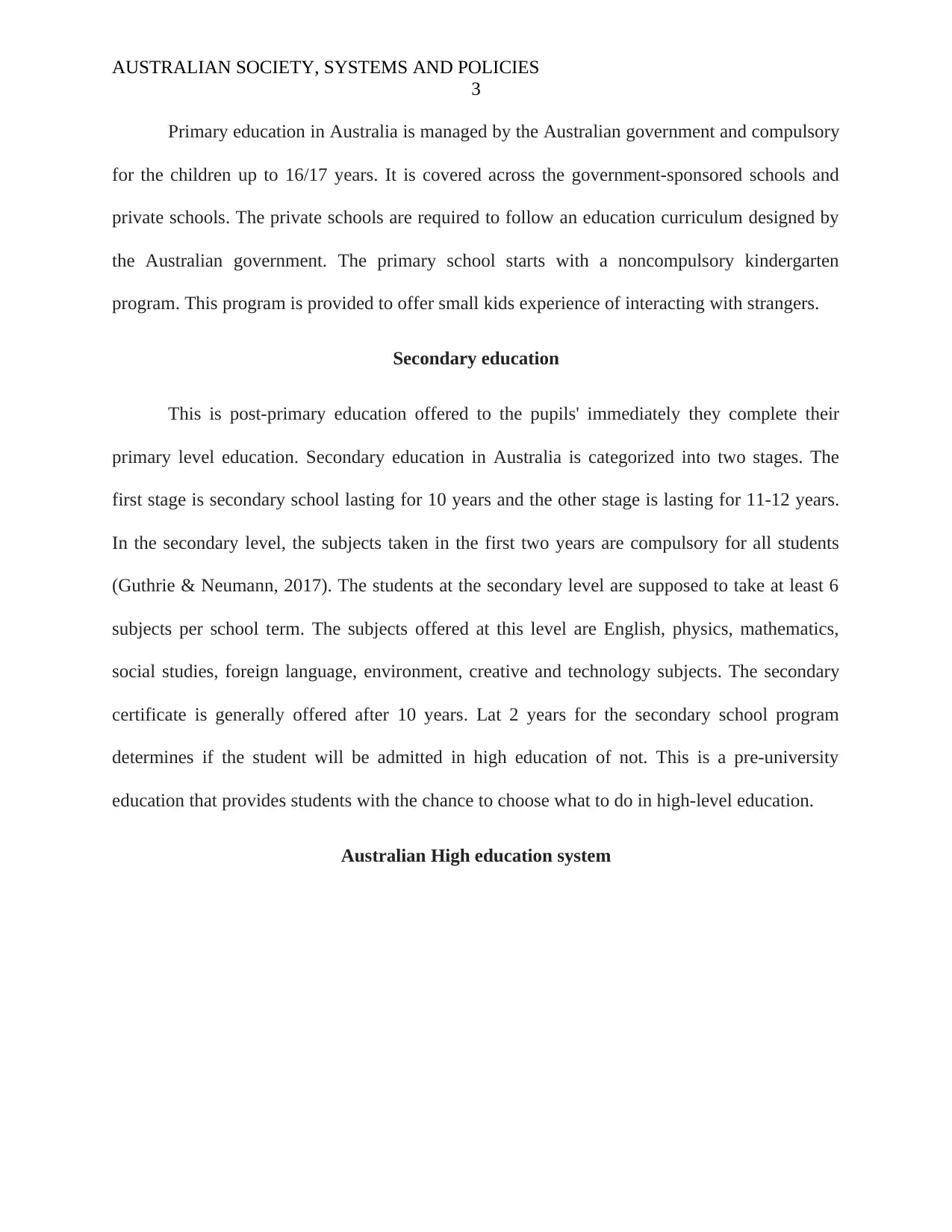
AUSTRALIAN SOCIETY, SYSTEMS AND POLICIES
3
Primary education in Australia is managed by the Australian government and compulsory
for the children up to 16/17 years. It is covered across the government-sponsored schools and
private schools. The private schools are required to follow an education curriculum designed by
the Australian government. The primary school starts with a noncompulsory kindergarten
program. This program is provided to offer small kids experience of interacting with strangers.
Secondary education
This is post-primary education offered to the pupils' immediately they complete their
primary level education. Secondary education in Australia is categorized into two stages. The
first stage is secondary school lasting for 10 years and the other stage is lasting for 11-12 years.
In the secondary level, the subjects taken in the first two years are compulsory for all students
(Guthrie & Neumann, 2017). The students at the secondary level are supposed to take at least 6
subjects per school term. The subjects offered at this level are English, physics, mathematics,
social studies, foreign language, environment, creative and technology subjects. The secondary
certificate is generally offered after 10 years. Lat 2 years for the secondary school program
determines if the student will be admitted in high education of not. This is a pre-university
education that provides students with the chance to choose what to do in high-level education.
Australian High education system
3
Primary education in Australia is managed by the Australian government and compulsory
for the children up to 16/17 years. It is covered across the government-sponsored schools and
private schools. The private schools are required to follow an education curriculum designed by
the Australian government. The primary school starts with a noncompulsory kindergarten
program. This program is provided to offer small kids experience of interacting with strangers.
Secondary education
This is post-primary education offered to the pupils' immediately they complete their
primary level education. Secondary education in Australia is categorized into two stages. The
first stage is secondary school lasting for 10 years and the other stage is lasting for 11-12 years.
In the secondary level, the subjects taken in the first two years are compulsory for all students
(Guthrie & Neumann, 2017). The students at the secondary level are supposed to take at least 6
subjects per school term. The subjects offered at this level are English, physics, mathematics,
social studies, foreign language, environment, creative and technology subjects. The secondary
certificate is generally offered after 10 years. Lat 2 years for the secondary school program
determines if the student will be admitted in high education of not. This is a pre-university
education that provides students with the chance to choose what to do in high-level education.
Australian High education system
⊘ This is a preview!⊘
Do you want full access?
Subscribe today to unlock all pages.

Trusted by 1+ million students worldwide
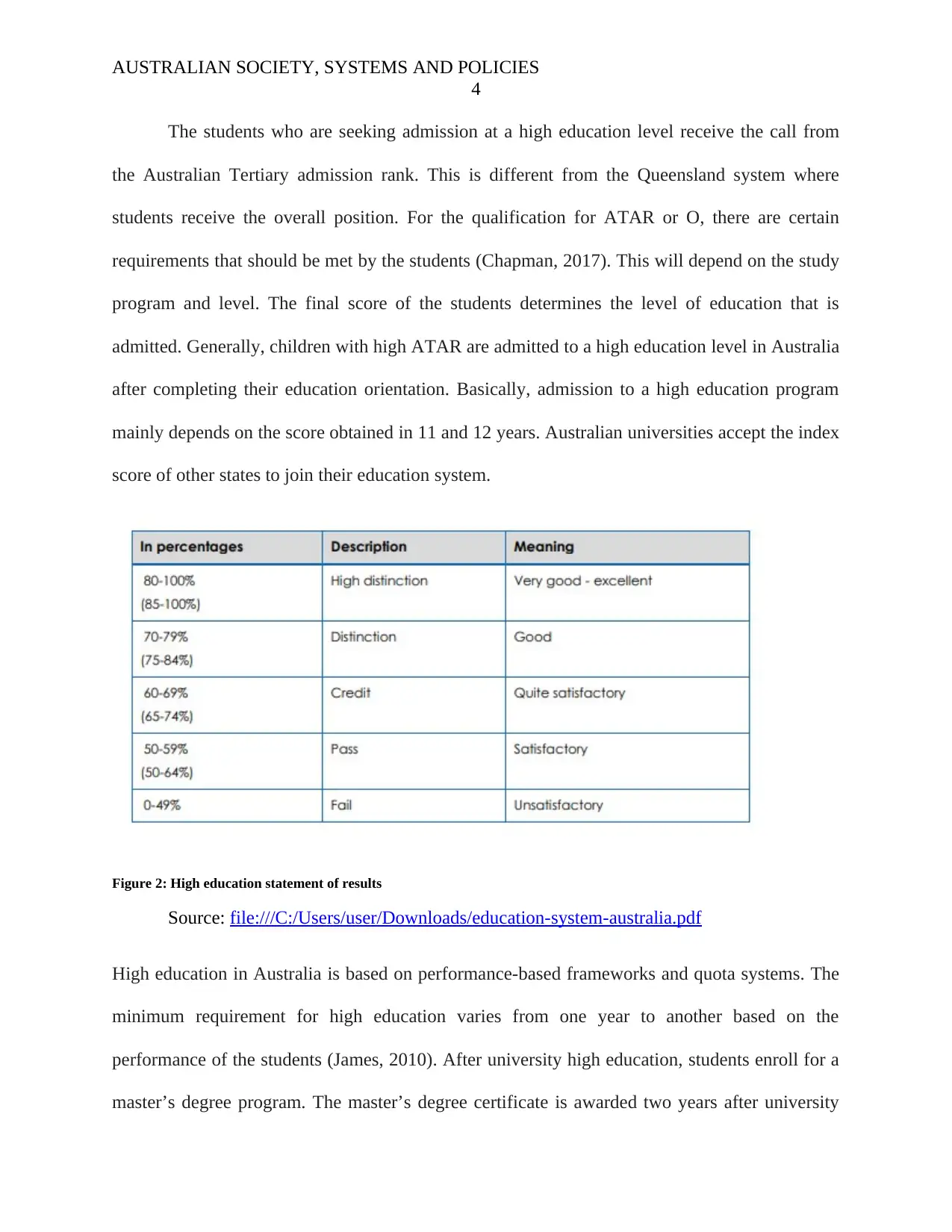
AUSTRALIAN SOCIETY, SYSTEMS AND POLICIES
4
The students who are seeking admission at a high education level receive the call from
the Australian Tertiary admission rank. This is different from the Queensland system where
students receive the overall position. For the qualification for ATAR or O, there are certain
requirements that should be met by the students (Chapman, 2017). This will depend on the study
program and level. The final score of the students determines the level of education that is
admitted. Generally, children with high ATAR are admitted to a high education level in Australia
after completing their education orientation. Basically, admission to a high education program
mainly depends on the score obtained in 11 and 12 years. Australian universities accept the index
score of other states to join their education system.
Figure 2: High education statement of results
Source: file:///C:/Users/user/Downloads/education-system-australia.pdf
High education in Australia is based on performance-based frameworks and quota systems. The
minimum requirement for high education varies from one year to another based on the
performance of the students (James, 2010). After university high education, students enroll for a
master’s degree program. The master’s degree certificate is awarded two years after university
4
The students who are seeking admission at a high education level receive the call from
the Australian Tertiary admission rank. This is different from the Queensland system where
students receive the overall position. For the qualification for ATAR or O, there are certain
requirements that should be met by the students (Chapman, 2017). This will depend on the study
program and level. The final score of the students determines the level of education that is
admitted. Generally, children with high ATAR are admitted to a high education level in Australia
after completing their education orientation. Basically, admission to a high education program
mainly depends on the score obtained in 11 and 12 years. Australian universities accept the index
score of other states to join their education system.
Figure 2: High education statement of results
Source: file:///C:/Users/user/Downloads/education-system-australia.pdf
High education in Australia is based on performance-based frameworks and quota systems. The
minimum requirement for high education varies from one year to another based on the
performance of the students (James, 2010). After university high education, students enroll for a
master’s degree program. The master’s degree certificate is awarded two years after university
Paraphrase This Document
Need a fresh take? Get an instant paraphrase of this document with our AI Paraphraser
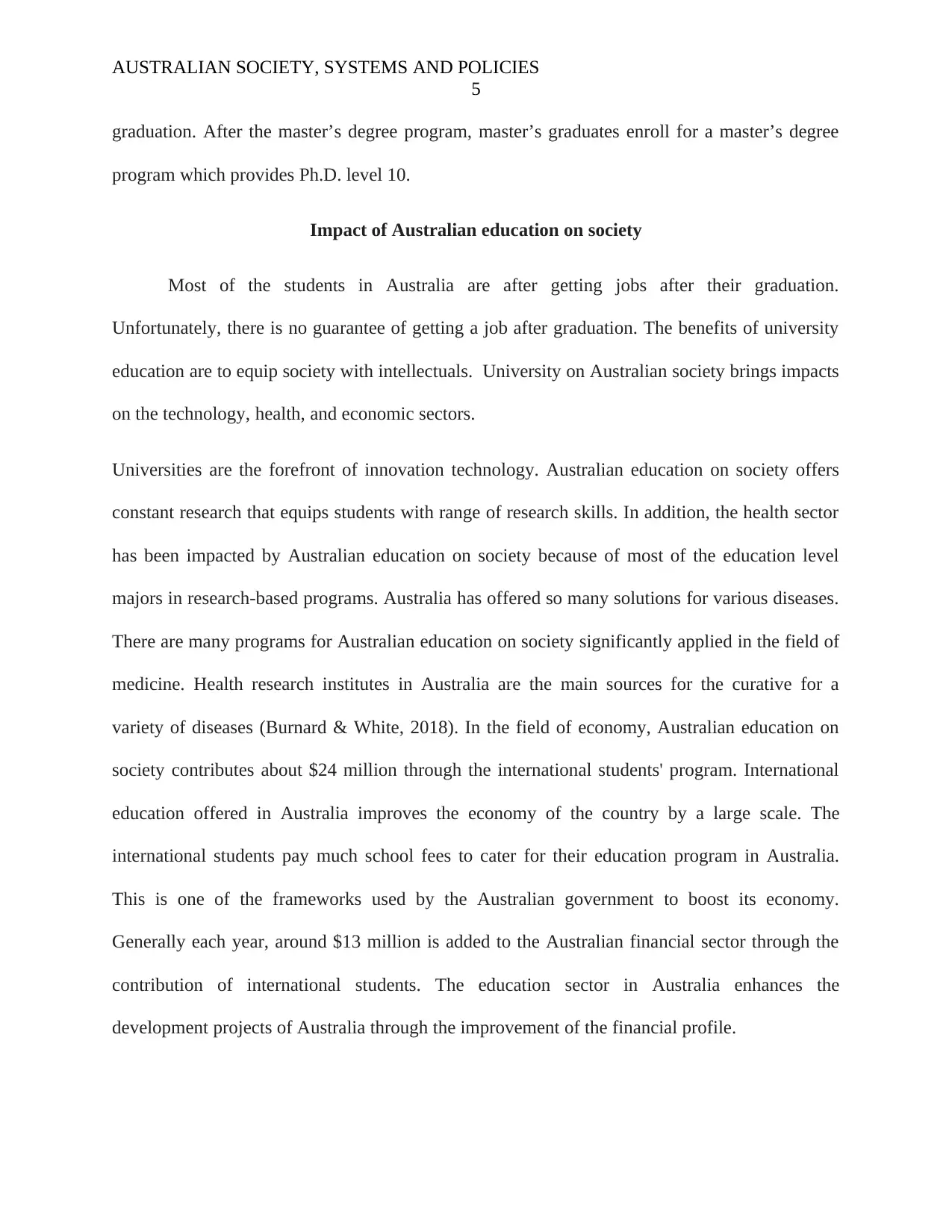
AUSTRALIAN SOCIETY, SYSTEMS AND POLICIES
5
graduation. After the master’s degree program, master’s graduates enroll for a master’s degree
program which provides Ph.D. level 10.
Impact of Australian education on society
Most of the students in Australia are after getting jobs after their graduation.
Unfortunately, there is no guarantee of getting a job after graduation. The benefits of university
education are to equip society with intellectuals. University on Australian society brings impacts
on the technology, health, and economic sectors.
Universities are the forefront of innovation technology. Australian education on society offers
constant research that equips students with range of research skills. In addition, the health sector
has been impacted by Australian education on society because of most of the education level
majors in research-based programs. Australia has offered so many solutions for various diseases.
There are many programs for Australian education on society significantly applied in the field of
medicine. Health research institutes in Australia are the main sources for the curative for a
variety of diseases (Burnard & White, 2018). In the field of economy, Australian education on
society contributes about $24 million through the international students' program. International
education offered in Australia improves the economy of the country by a large scale. The
international students pay much school fees to cater for their education program in Australia.
This is one of the frameworks used by the Australian government to boost its economy.
Generally each year, around $13 million is added to the Australian financial sector through the
contribution of international students. The education sector in Australia enhances the
development projects of Australia through the improvement of the financial profile.
5
graduation. After the master’s degree program, master’s graduates enroll for a master’s degree
program which provides Ph.D. level 10.
Impact of Australian education on society
Most of the students in Australia are after getting jobs after their graduation.
Unfortunately, there is no guarantee of getting a job after graduation. The benefits of university
education are to equip society with intellectuals. University on Australian society brings impacts
on the technology, health, and economic sectors.
Universities are the forefront of innovation technology. Australian education on society offers
constant research that equips students with range of research skills. In addition, the health sector
has been impacted by Australian education on society because of most of the education level
majors in research-based programs. Australia has offered so many solutions for various diseases.
There are many programs for Australian education on society significantly applied in the field of
medicine. Health research institutes in Australia are the main sources for the curative for a
variety of diseases (Burnard & White, 2018). In the field of economy, Australian education on
society contributes about $24 million through the international students' program. International
education offered in Australia improves the economy of the country by a large scale. The
international students pay much school fees to cater for their education program in Australia.
This is one of the frameworks used by the Australian government to boost its economy.
Generally each year, around $13 million is added to the Australian financial sector through the
contribution of international students. The education sector in Australia enhances the
development projects of Australia through the improvement of the financial profile.
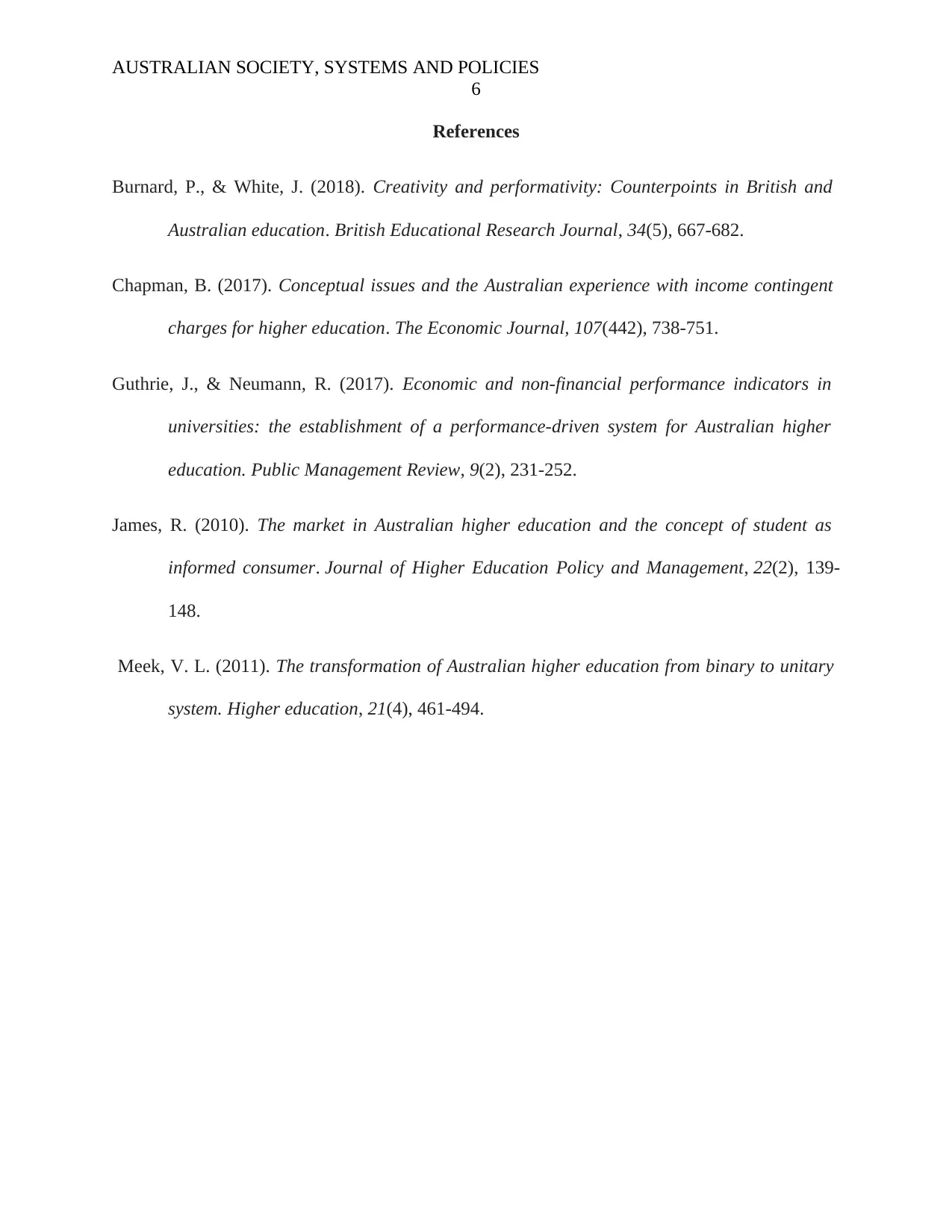
AUSTRALIAN SOCIETY, SYSTEMS AND POLICIES
6
References
Burnard, P., & White, J. (2018). Creativity and performativity: Counterpoints in British and
Australian education. British Educational Research Journal, 34(5), 667-682.
Chapman, B. (2017). Conceptual issues and the Australian experience with income contingent
charges for higher education. The Economic Journal, 107(442), 738-751.
Guthrie, J., & Neumann, R. (2017). Economic and non-financial performance indicators in
universities: the establishment of a performance-driven system for Australian higher
education. Public Management Review, 9(2), 231-252.
James, R. (2010). The market in Australian higher education and the concept of student as
informed consumer. Journal of Higher Education Policy and Management, 22(2), 139-
148.
Meek, V. L. (2011). The transformation of Australian higher education from binary to unitary
system. Higher education, 21(4), 461-494.
6
References
Burnard, P., & White, J. (2018). Creativity and performativity: Counterpoints in British and
Australian education. British Educational Research Journal, 34(5), 667-682.
Chapman, B. (2017). Conceptual issues and the Australian experience with income contingent
charges for higher education. The Economic Journal, 107(442), 738-751.
Guthrie, J., & Neumann, R. (2017). Economic and non-financial performance indicators in
universities: the establishment of a performance-driven system for Australian higher
education. Public Management Review, 9(2), 231-252.
James, R. (2010). The market in Australian higher education and the concept of student as
informed consumer. Journal of Higher Education Policy and Management, 22(2), 139-
148.
Meek, V. L. (2011). The transformation of Australian higher education from binary to unitary
system. Higher education, 21(4), 461-494.
⊘ This is a preview!⊘
Do you want full access?
Subscribe today to unlock all pages.

Trusted by 1+ million students worldwide
1 out of 6
Related Documents
Your All-in-One AI-Powered Toolkit for Academic Success.
+13062052269
info@desklib.com
Available 24*7 on WhatsApp / Email
![[object Object]](/_next/static/media/star-bottom.7253800d.svg)
Unlock your academic potential
Copyright © 2020–2025 A2Z Services. All Rights Reserved. Developed and managed by ZUCOL.




